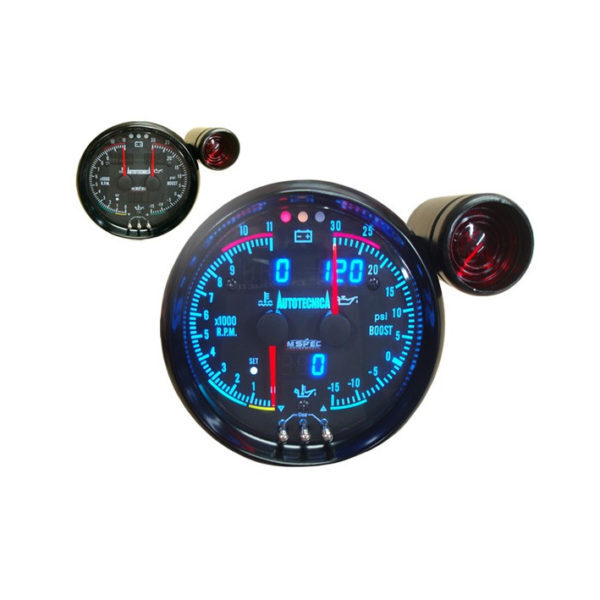Discover Exactly How a Tachometer Can Improve Your Car's Performance
Discover Exactly How a Tachometer Can Improve Your Car's Performance
Blog Article
The Value of a Tachometer in Keeping An Eye On Engine Rate and Efficiency in Automotive Applications
In the realm of auto design, the tachometer stands as an essential instrument in the vehicle driver's collection, providing a direct window right into the internal workings of a vehicle's engine. Beyond its function as a mere gauge of changes per minute (RPM), the tachometer acts as a vital tool for lovers and specialists alike, supplying real-time understandings right into engine efficiency and health. Comprehending the significance of this device exceeds surface-level monitorings, delving into the elaborate relationship between engine rate, power output, and overall driving experience. As we discover the multifaceted duty of the tachometer in vehicle applications, a much deeper admiration for its influence on automobile characteristics and efficiency begins to emerge.
Relevance of Checking Engine RPM
Checking engine RPM, or revolutions per min, is an important element of automotive maintenance and performance assessment. Engine RPM directly associates with the rate at which the engine's crankshaft turns, suggesting how swiftly the engine is running - tachometer. By monitoring RPM, auto mechanics can evaluate the wellness of the engine, spot prospective issues, and fine-tune efficiency. An uncommon RPM analysis might signal troubles such as engine misfires, malfunctioning spark plugs, or problems with the fuel distribution system. Regularly high RPM analyses could show hostile driving behaviors or the demand for a higher gear change to boost fuel efficiency.
Additionally, checking engine RPM is vital for efficiency evaluation in racing and high-performance cars. In summary, keeping an eye on engine RPM is not just essential for finding issues but additionally for maximizing engine efficiency in different vehicle applications.

Advantages of Real-Time Data
In auto applications, real-time information plays a critical role in giving instant understandings into the efficiency and condition of the vehicle. By continuously keeping an eye on numerous criteria such as engine rate, temperature, gas intake, and much more, real-time information supplies numerous advantages that add to boosted performance and safety when traveling.
One considerable advantage of real-time data is its capacity to alert vehicle drivers and service technicians to any type of anomalies or issues quickly. This proactive approach allows quick recognition of potential issues, permitting prompt treatments to avoid further damages or break downs. Furthermore, real-time information assists in performance optimization by providing instant feedback on driving practices and engine performance. Chauffeurs can change their actions in real-time based on this info to achieve much better gas economic climate and prolong the lifespan of their car.

Furthermore, real-time information plays an important role in modern-day automotive diagnostics, enabling professionals to promptly identify and resolve breakdowns. This causes minimized downtime, reduced maintenance expenses, and inevitably, boosted hop over to here overall car reliability and durability (tachometer). By using the power of real-time data, automobile stakeholders can make educated decisions that favorably affect both the efficiency and durability of the car
Influence On Equipment Shifts
The tachometer plays a critical role in optimizing equipment shifts by offering real-time engine rate data to the chauffeur. When coming close to the redline on the tachometer, it signifies the chauffeur to upshift to avoid over-revving the engine and causing potential damages.
Furthermore, the tachometer help in accomplishing smoother gear shifts, especially in manual transmissions. By monitoring engine rate, chauffeurs can execute gear shifts at the optimum RPM array, minimizing snagging movements and decreasing wear on the transmission components. This precision in equipment modifications not just enhances driving comfort however also adds to sustain effectiveness.
Enhancing Gas Performance
Offered the crucial duty the tachometer plays in enhancing gear changes for efficiency and engine wellness, it directly adds to maximizing fuel effectiveness in vehicle applications. By providing real-time responses on engine rate, the tachometer assists vehicle drivers in keeping one of the most reliable RPM variety for fuel economy. When chauffeurs regularly check the tachometer and change their motoring routines accordingly, they can prevent unnecessary gas intake triggered by over-revving or carrying the engine.
In addition, the tachometer helps drivers recognize the most fuel-efficient equipment to be in at any type of provided minute, preventing the engine from functioning more challenging than needed. This is specifically critical throughout acceleration and cruising, where being in the ideal gear can substantially affect gas effectiveness. Furthermore, the tachometer can inform drivers to potential mechanical problems that can be negatively affecting fuel economic climate, such as a slipping clutch or a clogged up air filter. In conclusion, the tachometer acts as a beneficial device in enhancing fuel effectiveness by promoting optimal driving routines and recognizing areas for improvement in the vehicle's performance.

Making The Most Of Engine Long Life
The tachometer's duty in keeping an eye on engine rate and performance is important in making sure the long life of automobile engines. Checking the tachometer permits vehicle drivers to remain within the recommended RPM variety for their lorry, avoiding unnecessary pressure on the engine and prolonging its lifespan.

Verdict
To conclude, the tachometer plays an essential duty in keeping an eye on engine rate and performance in automobile applications. By supplying real-time data on RPM, it enables for reliable equipment shifts, improved gas performance, and made best use of engine durability. This device is necessary for keeping optimum engine performance and guaranteeing the overall performance of an automobile.
Report this page